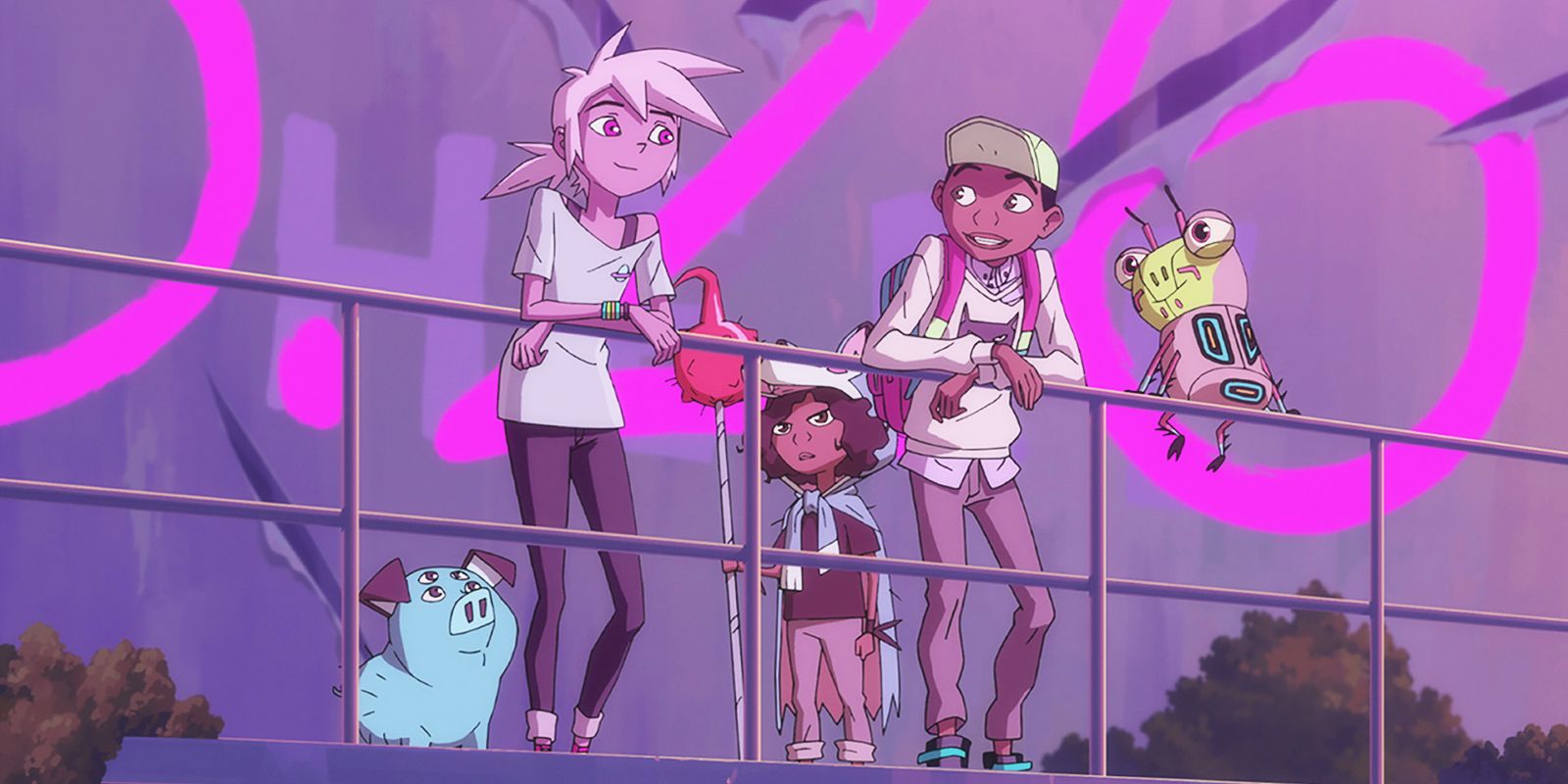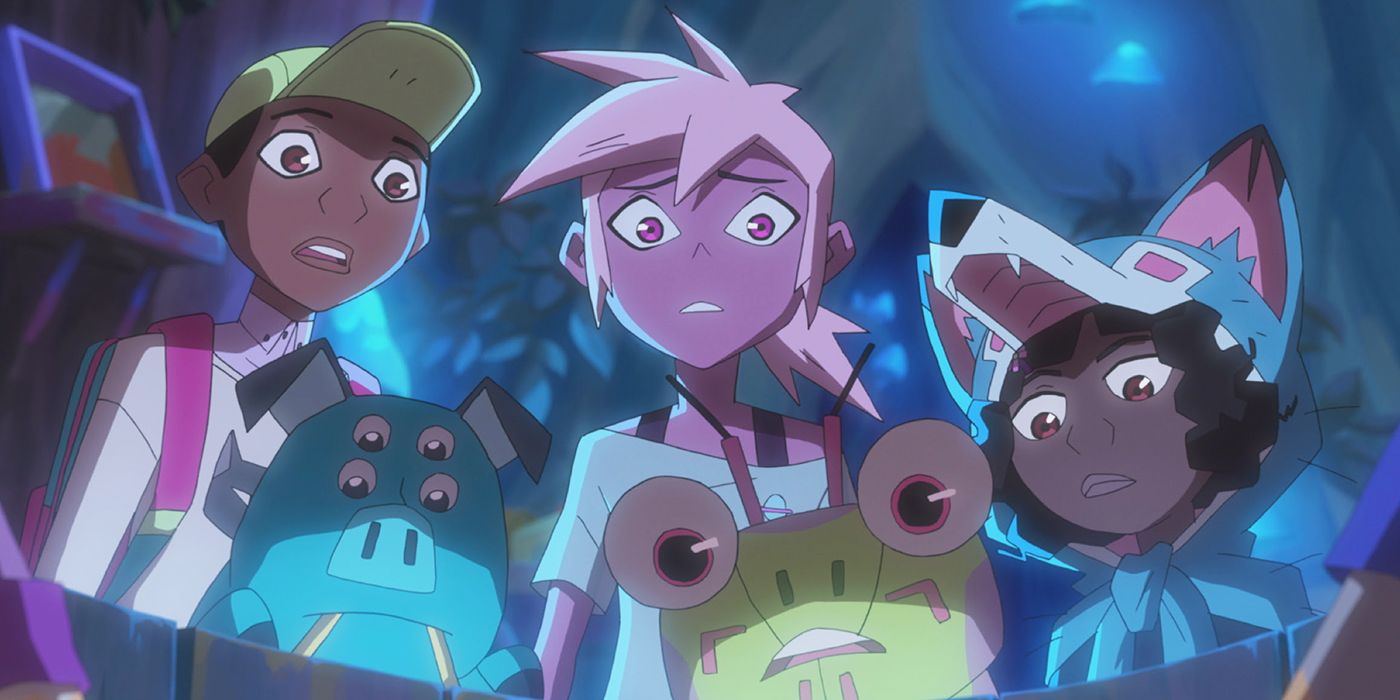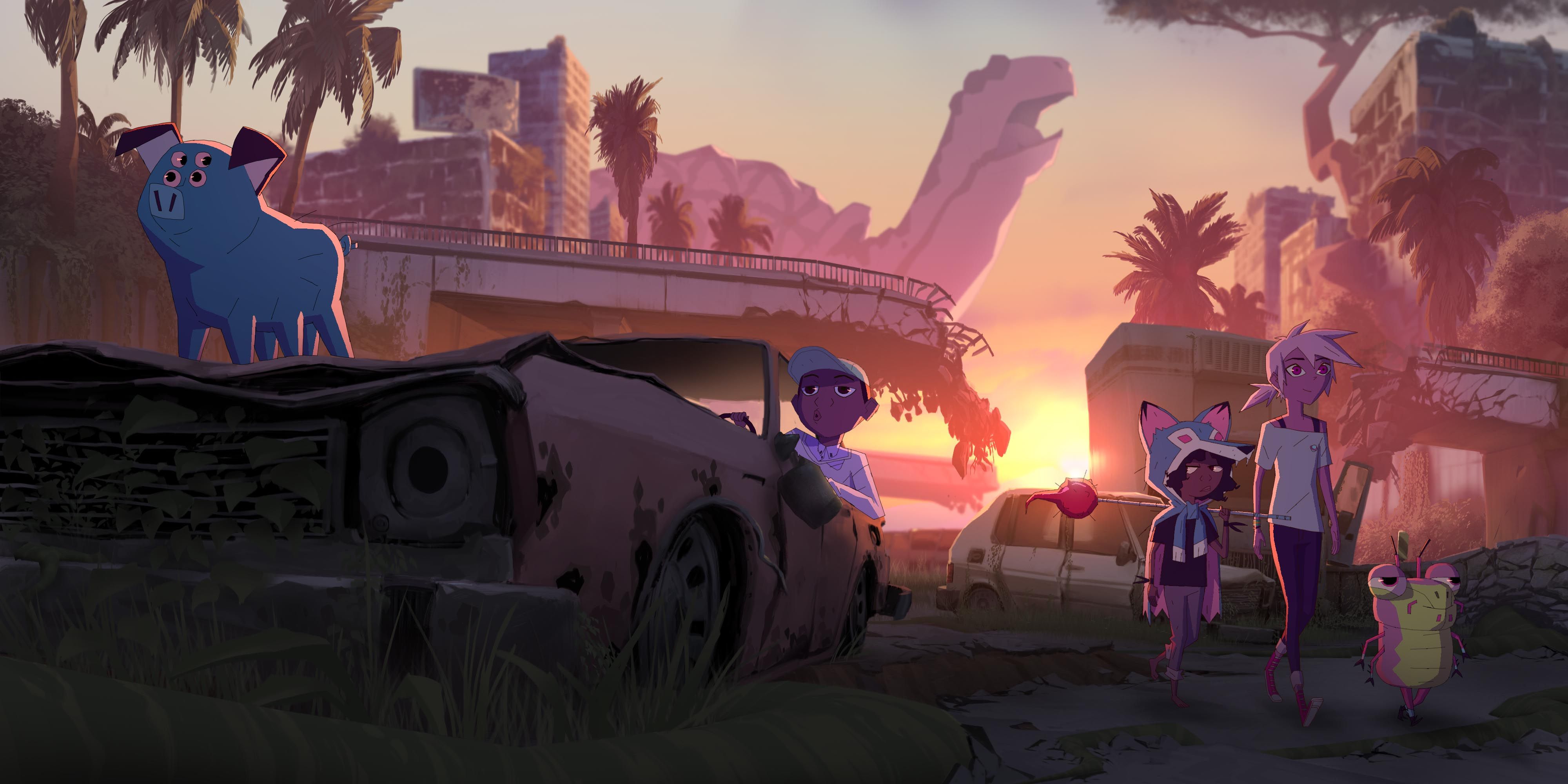Kipo and the Age of Wonderbeasts has finally returned for a stellar second season, which dropped on Netflix this past week. In the vein of recent animated series on the streaming platform, such as She-Ra and Voltron, Kipo uses youthful protagonists to delve into difficult topics. In the latter's case, it's a post-apocalyptic world where animals have gained the ability to speak and humans are often forced underground.
While the first season set up the mandrill Scarlemagne (Dan Stevens from Downton Abbey) as a mostly-unseen thread to Kipo (Karen Fukuhara, who coincidentally played Glimmer in She-Ra) and her friends, the second one explored his backstory and connection to Kipo's family in several surprising ways. And though Kipo's mission grew a lot bigger than merely finding her way home, her trusted friends Wolf (Sydney Mikayla), Benson (Coy Stewart) and Dave (Deon Cole) managed to remain by her side through some pretty tough Mega Jaguar times.
Kipo was originally based on a webcomic created by Radford Sechrist, but he quickly teamed up with Bill Wolkoff once the project was sold to DreamWorks. Together, the two have crafted a colorful world of mutated creatures that are impossible not to love and brought together a unique cast of characters tailor-made to brighten anyone's day. Screen Rant spoke with the showrunners about the balancing act between the cheerful nature of Kipo herself and the dangers of the world she's inhabiting, as well as well what inspired the villain trajectories of the second season and the already-infamous music choices.
One thing that I love about the show is how positive it is, even though it takes place in the middle of an apocalyptic wasteland. How do you manage the balance of heavy topics and a light-hearted tone?
Radford Sechrist: That's a good question for Bill. When you guys were in the in the writers room, was that on your mind? Or were you just making what you thought was cool?
Bill Wolkoff: I think it speaks to the character of Kipo and what it is that makes her so special to the surface world. It's her outsized relentless positivity. We knew from the very beginning that we wanted to do a show about the end of the world; that's in the DNA of Rad's webcomic. It's wonderfully absurd, but it is a very real world with real stakes. And it's a place where there's life and death stakes.
There's a power to presenting a world like that, where you have this lead character whose attitude is so strong. It's a world that can make most normal people become cynical and jaded. And that's just not her. She has the power to see the wonder within the danger, and that was an operating principle that we used for the entire series. So, we could try to make things as absurdly messed up as possible and put all of the cynicism in the world - and it's all over the world; it's even in Wolf to a huge degree. It goes up against the tornado of positivity that is Kipo.
Speaking of the webcomic, how often do you refer back to the origins as you get further into the series?
Radford Sechrist: You know, I only got 30 pages in, so she had just met Dave. Then it sold, and I immediately just took the webcomic down. Because I didn't want to keep going with the webcomic and have them go, "Wait a minute, we don't like this. You're making this into a show.?" So I just put it away and I'm like, "Alright, let's make the TV show now."
I didn't get that far ahead, but it was a similar thing. It was a giant ape with six arms that attacked her. And I kind of thought, "Well, she lived in a borough." You've seen the apes that take sticks and stick them in the anthill? It seems like that would happen with a giant mutant ape. And I had her get split up from her family. In the comic, it was her mom though. I think she was going to try to figure out how to find her mom again, and she met Wolf who is this Mad Max. And then she met Benson, who at the time looked like a giant Superman type dude. He was in his 40s with a beard. Dave was the same, though.
For Benson, I thought that it was really powerful to have him actually say he was gay in season 1, because a lot of times there'll only be undertones. Did you have to have any discussions behind the scenes about him not only getting to voice it but then have a little romance with Troy this season?
Radford Sechrist: I mean, when I pitched it to the studio, Benson was a gay character. And it was interesting, because one of the first things that Peter Gal - who is [Chief Creative Officer of Television] - said was, "You can have a gay character, but he has to say the words 'I'm gay.' It can't be ambiguous or hinted out." And me and Bill were like, "Well, that's great."
Bill Wolkoff: Yeah, we were lucky. I feel so fortunate that we made this show at a time when the studio empowered us to do that. From the time that I was brought on, and Rad and I mind-melded with each other, we wanted to show a world that was the world that we both know. A world that is underrepresented in animation. We wanted to have this young, 16-ish year old kid who is out and not ashamed of it and portray that as we've seen it among the people that are in our lives.
Happily, we were able to do that and really follow it through. Not only did Peter say that it needs to be explicitly stated, but they encouraged us in the follow through of that. I know that there's a lot of people that probably tried to do similar things before us that, historically, were not supported by studios or networks. I feel so glad that we got to do this at a time where we could, and that it had the impact that it has had.
There's a lot of diversity of all kinds in Kipo and the Age of Wonderbeasts, both onscreen and behind the scenes. Has that helped inform the story, either by reducing elements that could be harmful or incorporating storylines that would fall by the wayside without those real voices present?
Radford Sechrist: Some of the influence that we experienced [came from that]. For instance, when we were casting Kipo's dad, our director Chris came in the office and was like, "You're making Kipo's dad black. I want a black dad on screen." And we're like, "Okay." A lot of times that's coming from the studio. We have a non-binary character, because we had a couple of non-binary people working on the staff that asked for that. So, I think sometimes when you're surrounded by that, it kind of influences the show.
One storyline I really loved was Wolf coming to terms with the fact that Kipo is a mute. Her whole trajectory has taken her from fear and hatred of them to standing right by Kipo's side in order to protect them. How did you develop Wolf's backstory, and was it a natural progression for her or did you plot it out?
Radford Sechrist: It's kind of interesting, because when I first designed Wolf, I drew her with the wolf pelt, but I never followed that through with what that meant. But when Bill looked at it, the first thing he thought was, "Wait a minute, that wolf must have talked at some point. And she doesn't seem like a bad person, so there must be a reason why she killed that wolf." And then I remember, Bill, you pitched me what you were inspired to do with it. I don't know if you want to talk about a little bit.
Bill Wolkoff: Sure. I was inspired by Wolf's design and by the wolf pelt. It seemed like a really natural way to play out what's been happening on the surface, and how dangerous it is. While it's a world full of wonders, it's also a world full of dangers - and Wolf represents that.
She's a survivor, and that's what's so wonderful about her. She is an unapologetic survivor, and she's not bitter but she's also not going to forget what happened in the past. It's hardened her. And it was important to have somebody have that level of betrayal and bitterness in their past go up against Kipo. We see what's going to happen when they meet Kipo; will she be able to pull them through that?
And then it was like, "How badly can we betray poor Wolf?" We had a lot of talks about where that was going to play out. We had a feeling that if we played it out where we did in season 1, after you've seen Wolf so much, you'd feel for her. You wouldn't be afraid that she was going to get killed, but you would feel that betrayal - and it would really make you understand why she's essentially prejudiced against all mutes.
So, that's how that Most Dangerous Game-type story evolved for young Wolf. I love Wes Anderson movie, so I was like, "What if was in a Wes Anderson prep school for wolves that turns out to be a hunting ground for humans?"
Meanwhile, the music for Kipo is spectacular. Not only am I vibing to every song and instrumental piece from the show, but it feels like every character has their own musical style that still fits right into the show. What is the process of incorporating the songs into the show?
Radford Sechrist: Kier Lehman and James Cartwright are our music supervisors, so they would bring us the found music, like songs we would use as well as score. We would put in a temp song that we liked, and then either [Kipo's composer Daniel Rojas] would recreate his own version of that, or James and Kier would bring us a song within our budget that had a similar vibe. But that was really fun.
Bill Wolkoff: Kier and James are both geniuses at finding affordable music that does the same thing as the needle drops that that Rad and I initially put in, which would have been the entire budget of the show.
Radford Sechrist: I'll give you an example. We put Johnny Cash's "Hurt" during the scene where Jamack's walking, and they found us that "I cried 10,000 tears" song. It has a similar kind of vibe that we can afford.
Bill Wolkoff: And that got me loving Yvonne Devaney, who's like this Patsy Cline that nobody in the world had ever heard of. James and Kier found her, and I'm like, "Oh my God! I actually like this better than 'Hurt.'"
Radford Sechrist: They would bring us songs that I'm like, "How is this song not on the radio?" Like that "In LA drinking Kombucha" song from the Brunchington Beach episode. I'm like, "Dude, how have I not heard this song?"
In the second season, we get a lot more backstory and flashbacks for Kipo's family and Scarlemagne. How early on did you decide how close they were?
Radford Sechrist: As far as I can remember, we knew that was the case, but we didn't know how it would unfold, right?
Bill Wolkoff: When Brad and I first started talking about the show, in its earliest development stages, we knew that we wanted Scarlemagne to have a very personal connection to Kipo. And with the real estate that we had for season 1, we also knew that we wanted to build him up as this scary presence offscreen before you actually see him. So, you need time for that.
Season 1, he's going to be this this scary, larger-than-life presence, but we're not going to dig into him that much. But we knew that we wanted to have a real personal connection. We talked about this idea that didn't wind up on the show, that Kipo actually finds an old photograph somewhere of her as a baby with her parents and a smiling Scarlemagne.
We brought that concept into the writers’ room, and then for season 2, we just had endless discussions about the best way to dramatize what Kipo's real connection to Scarlemagne was. And that is the product of a lot love, sweat and tears from our entire writing staff, as we played that out. Ben Meckler and Chris Amick brilliantly dramatized it in their season 2 scripts, where you see his backstory.
And whose love, sweat and tears came up with Scarlemagne as a Versailles reject? His Louis XIV vibe was epic.
Radford Sechrist: Bill came to me and was like, "Hey, what if he's kind of modeled off Amadeus from Mozart?" And I showed him an old drawing of an early design I had done, with the very first gang I had come up with. It was a human gang, but they were all dressed like Louis XIV. I already had the outfits designed, and I had never even showed it to him before. But how funny is that?
Bill Wolkoff: And that led to us thinking about how in Southern California, there's lots of themed cheesy themed shopping malls. Like, there's a Babylon-themed shopping mall.
Radford Sechrist: There's a French one with a fake Eiffel tower.
Bill Wolkoff: So, then we're like, "Okay, what if there's an abandoned Versailles-themed shopping mall that he has taken over and made his palace?" That just felt like the right tone that we wanted for the show.
Radford Sechrist: One of my favorite things is how Dee Bradley Baker does Gerard. If you'll notice, he's trying to put on a fake accent like Scarlemagne, but he has this weird kind of Keanu Reeves bro natural voice. You don't realize why he's doing that until you realize he was a mallrat and Scarlemagne makes him dress like that.
Scarlemagne felt like the big bad in season 1, but ever since Kipo met the Mega Monkey, we knew there was someone else lurking. At what point did Dr. Emilia as the even scarier villain fall into place for you?
Radford Sechrist: We definitely knew that Scarlemagne never had control of the Mega Monkey, it was someone else. But, again, the specific details we didn't know.
Bill Wolkoff: We did have in our heads that we wanted one big bad that comes from the mute world and who's a very anti-human presence. And then we wanted to bring in, "If you thought that one was bad, wait until you see the anti-mute human that's even worse." It was just finding the right way to go about it. That was two years of talking with our writing staff to figure out how to plan that out.
Netflix has a delightfully fast turnaround with animated series, and you were finished with the second season before the first came out. Is that also true season 3, or is that one going to take longer?
Radford Sechrist: Well, I don't know. I don't know if there's a season 3.
Bill Wolkoff: We hope!
The first two seasons of Kipo and the Age of Wonderbeasts are currently available to stream on Netflix.



